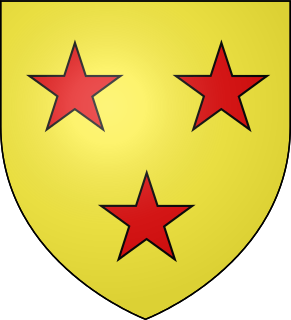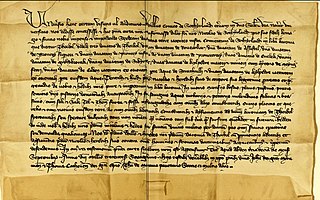Related Research Articles

Clan Mackay is an ancient and once-powerful Highland Scottish clan from the far North of the Scottish Highlands, but with roots in the old Kingdom of Moray. They supported Robert the Bruce during the Wars of Scottish Independence in the 14th century. In the centuries that followed they were anti-Jacobite. The territory of the Clan Mackay consisted of the parishes of Farr, Tongue, Durness and Eddrachillis, and was known as Strathnaver, in the north-west of the county of Sutherland. However, it was not until 1829 that Strathnaver was considered part of Sutherland when the chief sold his lands to the Earls of Sutherland and the Highland Clearances then had dire consequences for the clan. In the 17th century the Mackay chief's territory had extended to the east to include the parish of Reay in the west of the neighbouring county of Caithness. The chief of the clan is Lord Reay and the lands of Strathnaver later became known as the Reay Country.

Clan Sutherland is a Highland Scottish clan whose traditional territory is the shire of Sutherland in the far north of Scotland. The chief of the clan was also the powerful Earl of Sutherland, however in the early 16th century this title passed through marriage to a younger son of the chief of Clan Gordon. The current chief is Alistair Sutherland who holds the title Earl of Sutherland.
Donald Mackay, 1st Lord Reay, 14th of Strathnaver was a Scottish soldier and member of Parliament. He played a prominent role in the Thirty Years' War, raising a regiment of 3,000 men, which served in both the Danish and Swedish forces. He was later an unwilling Covenanter. He was the fourteenth chief of Clan Mackay, a Highland Scottish clan.
The Battle of Torran Dubh also known as the Battle of Torran-dow or the Battle of Torran Du was a Scottish clan battle that was fought in 1517 in Sutherland, in the Scottish Highlands.

The Battle of Alltan-Beath also known as the Battle of Ailtan-Beath was a Scottish clan battle said to have taken place in the year 1542 in the village of Knockarthur, in Sutherland, in the Scottish Highlands. It was fought between men of the Clan Mackay and men of the Clan Sutherland whose chiefs were the Gordon, Earls of Sutherland.

William de Moravia was the 5th Earl of Sutherland and chief of the Clan Sutherland, a Scottish clan of the Scottish Highlands. William, 5th Earl of Sutherland was a loyal supporter of David II of Scotland in the wars against England.

Dingwall Castle was a medieval fort and royal castle in the town of Dingwall, eastern Ross-shire, Scotland.
Huistean Du Mackay, 13th of Strathnaver, was the thirteenth chief of Clan Mackay, a Highland Scottish clan.
Angus Du Mackay, 7th of Strathnaver was the seventh chief of the Clan Mackay, a Highland Scottish clan. He is recorded in the 15th-century Scottish chronicle, Scotichronicon, as Enneas-en-Imprissi meaning Angus the Absolute due to his power of commanding 4000 men.
John Gordon, 11th Earl of Sutherland (1525–1567) was a Scottish magnate. John Gordon supported the chief of his family, his cousin the Earl of Huntly against the Earl of Moray. After Huntly's defeat at Corrichie, he went into exile, and shortly after his return to Scotland he was murdered by a kinswoman.
The Murrays of Aberscross were a minor noble Scottish family who were seated at Aberscross Castle, in the county of Sutherland, Scotland. The Murrays in Sutherland are recorded specifically as a clan in two Acts of the Scottish Parliament of the 16th century.
Iye Du Mackay, 12th of Strathnaver, was the chief of the Clan Mackay, a Highland Scottish clan, from 1550 to 1572.

The Mackays of Scoury were a minor noble Scottish family and a branch of the ancient Clan Mackay, a Highland Scottish clan. They were seated at Scourie Castle, in Scourie, in the parish of Eddrachillis, county of Sutherland. However, Scourie was part of the Mackay chief's province of “Strathnaver” until it was sold to the Earl of Sutherland in 1829.
Iye Mackay, 4th of Strathnaver was the chief of the ancient Clan Mackay, a Scottish clan of the Scottish Highlands. He was murdered along with his eldest son Donald at Dingwall Castle during a feud with the Earl of Sutherland, chief of the Clan Sutherland.
Donald Mackay, 5th of Strathnaver, was the fifth chief of the ancient Clan Mackay, a Scottish clan of the Scottish Highlands.
Iye Roy Mackay, 10th of Strathnaver, was the tenth chief of the ancient Clan Mackay, a Scottish clan of the Scottish Highlands.
John Mackay, 11th of Strathnaver, was the eleventh chief of the ancient Clan Mackay, a Scottish clan of the Scottish Highlands.

The Stand-off at Bengrime took place in 1601 and was a stand-off between the armies of John Gordon, 13th Earl of Sutherland and George Sinclair, 5th Earl of Caithness. Bengrime is in the county of Sutherland, Scotland.

Nicholas Sutherland, 1st of Duffus was a Scottish noble who was seated at Duffus Castle, near Elgin, Moray, Scotland in the 14th and 15th centuries.

William Sutherland, 6th of Duffus was a member of the Scottish nobility and a cadet of the Clan Sutherland.
References
- ↑ Mackay, Angus (1906). The Book of Mackay. 25 George IV Bridge, Edinburgh: Norman MacLeod. pp. 77-78. Retrieved 9 December 2020.
{{cite book}}: CS1 maint: location (link) - 1 2 3 4 5 6 7 8 9 10 11 12 13 14 15 16 17 18 19 20 21 22 23 24 25 26 27 28 29 30 31 32 33 34 Mackay, Angus (1906). The Book of Mackay. 25 George IV Bridge, Edinburgh: Norman MacLeod. pp. 86-93. Retrieved 9 December 2020.
{{cite book}}: CS1 maint: location (link) - 1 2 Mackay, Robert (1829). "Donald Mackay 1529-1550". History of the House and Clan of the Name MacKay. 233 High Street, Edinburgh: Printed for the author by A. Jack. pp. 114-118. Retrieved 9 December 2020.
Quoting: Gordon, Sir Robert (1580–1656), A Genealogical History of the Earldom of Sutherland
{{cite book}}: CS1 maint: location (link) - ↑ "The Conflict of Aldine-beh". The History of the Feuds and Conflicts among the Clans in the Northern Parts of Scotland and in the Western Isles. Glasgow: Printed by J. & J. Robertson for John Gillies, Perth. 1780 [Originally published in 1764 by Foulis press]. pp. 21-22. Retrieved 9 December 2020.
Written from a manuscript wrote in the reign of James VI of Scotland (Sir Robert Gordon's A Genealogical History of the Earldom of Sutherland).
- ↑ Mackay, Angus (1906). The Book of Mackay. p. 93. Quoting: Pitcairn's trials I., 352.